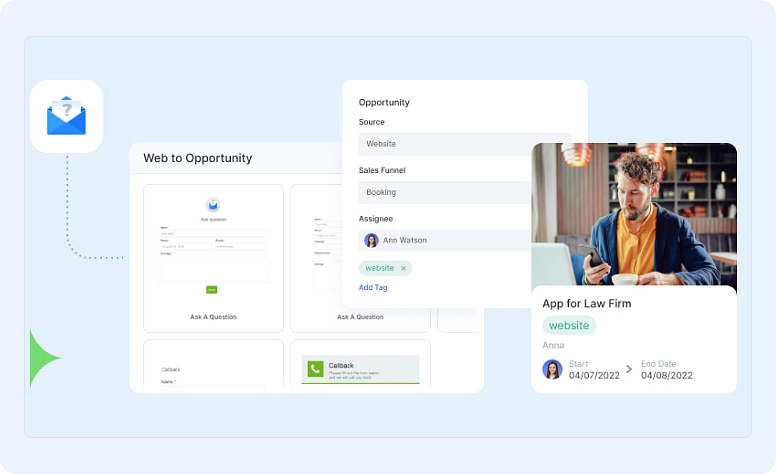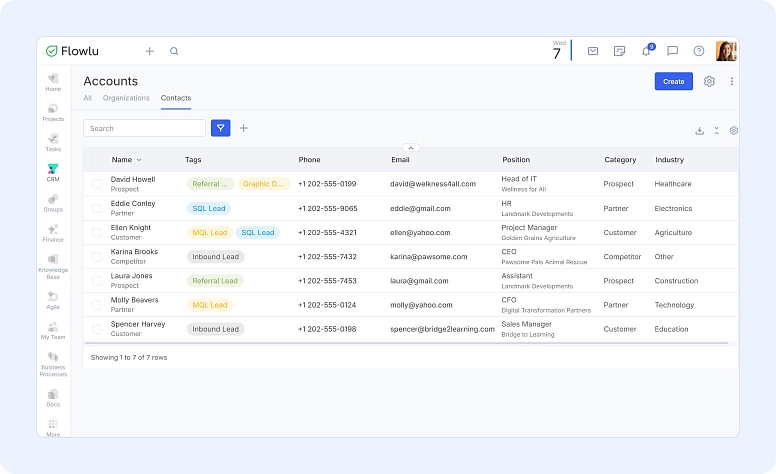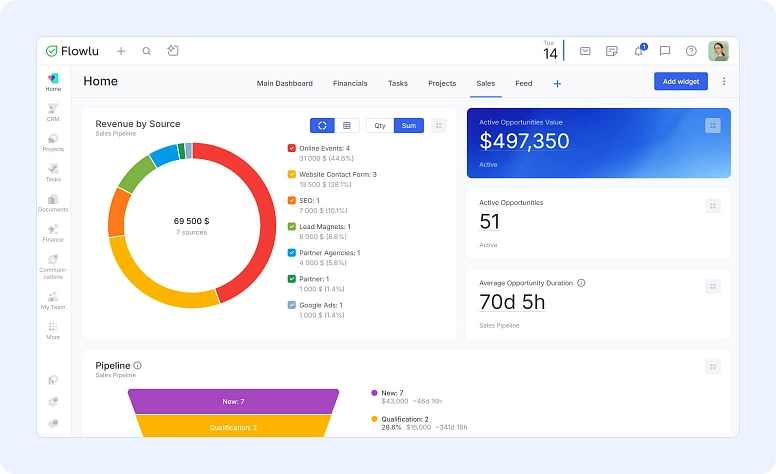5 Simple Ways Your CRM Can Fix Your Website and Make It Convert
Enterprises use customer relationship management (CRM) systems to plan sales and marketing, save time on daily tasks, and give customers a better experience. CRM solutions work well, some studies show an average CRM ROI of 211%. It can be even higher, up to 600%, when companies use the software fully and get their teams on board.
If you want to build a website for your business or make your current one better, then CRM data can help you to make smart choices. For example, you can see what your customers like and then use this knowledge to build a site that speaks to them and brings more sales.
Also, CRM data can help to make your SEO better, to make your content stronger and to bring more people to interact with your website. It can even show you small problems that normally are easy to overlook.
Want to know how to do this? Here’s how CRM data can help make your website bring in more visitors and sales.
Why is CRM data so important?
Modern CRM software is not only a place to keep customer information. Also, many CRMs have tools for marketing, for making reports and for tracking sales. They can connect with other systems you use, like tools for finance, support, or HR. This gives you a full picture of your business in one place.
With CRM, all customer data is together. This makes it easier to understand your audience and talk to the right people. You can use this data to:
- Find your best customers
- Improve your SEO and content
- Make your sales process better
- Give customers a more personal experience
- Match your sales and marketing messages
- Guess what customers may need next
- Bring back leads who stopped responding
For example, if you have an online store on Wix or Shopify, then your CRM can show which products sell the best, which pages people leave very fast and who does not go further than the homepage.
This also helps you see customer habits and trends. You can then change your website content, stock, or calls to action to match what people want. This can save money, avoid extra stock, and grow your sales.
CRM data is just as helpful for service-based businesses. For example, if you are a personal trainer, your CRM may show that people who buy nutrition coaching stay with you longer than people who only buy workout plans. These clients are more valuable.
You can then show nutrition plans more clearly on your site, maybe with a special offer. This way, you can use your website and marketing to bring more long-term clients.
This brings us to the next point…
How CRM data helps you make better website decisions
CRM data can help you to understand your audience better and to see how your website is doing. It shows what works good and what still needs to be improved. Here are some simple examples.
|
CRM Insight |
What It Means |
What You Can Do |
|
Key pages with high traffic but low conversions |
People visit these pages but don’t take action |
Make your CTAs clearer, make forms shorter, or adjust pricing to remove hesitation. |
|
Many abandoned carts or forms |
Something in the process makes visitors stop |
Make checkout easier, add live chat, or show trust signs like reviews or testimonials. |
|
Returning visitors who don’t convert |
People are interested but not fully convinced |
Add FAQs, social proof, or product demos to help them decide. |
|
Top referral sources (e.g., Instagram) |
Shows where most traffic comes from |
Make landing pages match each traffic source for better results. |
|
Customer demographics |
Shows age, location, job, or interests of your visitors |
Adjust design, words, and images to fit your audience better. |
|
Seasonal buying patterns |
Shows when people buy the most |
Plan your sales, promos, and emails for the right time. |
This kind of insight helps you to make your content, your products, or your services fit to each group of customers better. Depending on the data you collect, also your SEO, your email marketing and your ads can work smarter and cost less.
It can be something very simple, like making your menu easier to use, putting your best products in the right place or changing your words so they speak clearer to your visitors. The main idea is to use what the data is telling you, to test your changes, and to make it better step by step.
1. Know your visitors and group them smartly
CRM data helps you to understand who is coming to your website. You can look at details like age, location, income, job, or hobbies. This makes it possible to make your website speak more direct to each group of people.
For example, imagine you give online yoga classes. After checking your CRM data, you see that your most active clients are women in their 30s with good income who like short and flexible workouts.
From this you can do many things. You can use images that show people like them. You can offer class packages that fit their time. Furthermore, you can add reviews or testimonials from similar clients to build trust.
Also, you can divide your visitors into groups, for example new visitors and returning clients:
- Show different CTAs to each group
- Recommend the right products or services
- Adjust the content to match their needs
When your site speaks directly to the right people, they’re more likely to stay, trust your brand, and take action.
2. Shape your site around real customer needs
CRM data can help with almost every decision when you build or make your website better. It shows who your customers are, what they like, and what makes them take action.
For example, if your audience is mostly business owners in finance or consulting, then your website should look clear and professional.
- Dark colors like black and gray show authority.
- Navy blue builds trust.
- Green makes people think of growth and stability.
- Use simple, modern fonts and avoid playful styles that might look too casual.
But if your audience is young people who love fashion, your site can look brighter and more fun.
- Colors like pink, coral, or lavender bring energy.
- Rounded or handwritten fonts make it feel friendly and personal.
The layout and images should also match the audience.
- Finance professionals usually prefer a clean, simple design with clear information.
- Young shoppers often like creative images and scrolling effects that look more visual and fun.
When your site fits what your real customers want, then it feels more natural for them and they are more likely to stay and to buy.
3. Find the words your customers actually use
Many businesses use tools like Semrush or Moz to find keywords. This works, but your CRM can give you something even better: the real words your customers use.
You can look at:
- Chat messages
- Support tickets
- Email conversations
This helps you understand how people really talk about your product or service.
For example:
- A trainer may see “flexibility training” is used more than “static stretching.”
- A bakery may find people say “gluten-free birthday cake” instead of just “birthday cake.”
When you use these exact words in your product pages, blog posts, or ads, your site becomes easier to find in search. It also feels more personal because you speak the same way your customers do.
CRM data also shows user intent: what people really want.
- Some searches are just for information.
- Others show people are ready to buy.
If a page has many visits but few sales, that’s a sign to make a change. You can:
- Add a clearer CTA
- Recommend products that match what they’re looking for
- Offer a special deal or a quick way to take action
Using your customers’ real words helps your website connect better and convert more.
4. Show the right content to the right people
According to management consulting firm McKinsey, 71% of people expect a personal experience from brands, and 76% feel frustrated when they don’t get it. Personalization also brings real growth — fast-growing companies make 40% more of their revenue from personalized interactions than others.
Your CRM can help you give this personal touch. You do not need to guess what people want. You can use real data like what they do on your site or simple information like age, interests or location. Then you can make blog posts, guides, videos or special offers that fit what each group needs.
For example:
- If many of your visitors are returning customers who buy organic skincare, show body lotions, face creams, and soaps on your homepage.
- If someone is new, show them a simple “Start Here” offer or guide.
- A gym might show different banners depending on what the visitor cares about, for example weight loss, muscle gain or aerobics.
When people see content that fits to their needs, they are more likely to stay, trust your brand and buy..
5. Turn website visits into real sales
Your CRM can also show what people buy, what they like, and what they might want next. You can use this to make more sales by:
- Suggesting extra products (cross-sell)
- Recommending better or bigger options (upsell)
- Giving personal discounts or special offers
For example:
- If someone buys organic face cream, offer them an exfoliating scrub or body lotion a few weeks later.
- If you have a photography business and people usually upgrade after seeing better retouching, show those “before and after” images right on your service page.
- If a customer buys lip balm often, offer them a lip care set at a special price.
These small steps can make customers feel seen and appreciated, and that can turn a simple visit into a real sale.
3 easy ways to do this with Flowlu CRM
CRM data is only useful when it is connected to your website and brings real change. Here are three simple ways to do this with Flowlu and its built-in tools.
1. Add your website forms to Flowlu
A very effective way to turn visitors into real leads is to connect your website forms with your CRM. In Flowlu, this happens automatically.
Flowlu gives you ready Web-to-Opportunity forms that you can place on your landing pages.
When someone fills out the form:
- An opportunity is created in your CRM right away.
- The lead is sent to the right sales person.
- It goes into the correct pipeline for fast follow-up.
Example: If most leads from your pricing page are agencies, you can create a special “Agency” pipeline and landing page for them. This makes your message more clear and increases conversions.
If you want to keep your own forms (for example from your CMS, WordPress, or landing page builder), you can still connect them with Flowlu using Make or Pabbly.
This way, you keep your design but still collect every lead directly in Flowlu.
2. Use segments to show what people care about
When leads start to come into Flowlu, you can put them into groups with tags, categories or custom fields. For example, you can make groups like freelancers, agencies, or SaaS companies.
These groups help you to use the data smarter. Flowlu itself does not change what other websites show. But it gives you the information, so you can adjust your own website and your marketing based on these groups. You can show the right banners and buttons for each group and create offers that fit better to their needs. Also you can change the text and the visuals, so the message speaks more clear to them.
When you connect these groups with your marketing tools, then you can also make more focused campaigns or follow-up messages outside the website.
Example: Freelancers can see a “Start Free” button, and agencies can see “Book a Demo.” This small change can make a big difference how people react.
3. Check results and make small fixes often
CRM data is very helpful to see what works on your website and what does not. With Flowlu’s dashboard and reports, you can watch which channels and forms bring the best leads — not only the most visitors.
It also helps you to see which pages bring good leads, which traffic sources do not convert and where people stop. With this information you can make simple but smart changes to your CTAs, landing pages and offers. When you do this one time per month or every few months, your website stays fresh and works better.
Example: If your blog brings many leads but not many deals, you can change the CTA or add a more focused lead magnet to get better results.
Turn your website into a growth tool
Modern CRMs can collect data from almost every interaction with your customers. This can be from emails, purchases, social media or other activities. This gives you clear facts instead of guesswork and helps make your sales and marketing stronger. It also supports better SEO, better content and better targeting.
With this data, you can make more smart decisions. You can see which topics bring more engagement and then adjust your content so it fits better to what people like. This usually brings more visitors, more clicks and a smoother website experience.
CRM data can also help you build trust, sell more and grow your profit. One simple way is to make your CTAs and product offers more personal, based on what people buy, how they behave and when they are most active.
But remember. CRM data alone is not enough. It gives you a direction, but you must act. Try different ideas, see what works best for your audience, and keep improving step by step.
No. You can start small. For example, you can add a CRM form to your website, use tags for your leads, and check which pages bring good customers. Later, you can try more advanced things like customer groups or A/B tests.
We think, you should check your data about once a month. Thus, you can see what works well and what doesn’t. After that, you can change your buttons, pages, or content to get better results.
Yes. Many website builders and CRM tools make it easy, so you don’t need to write any code.















